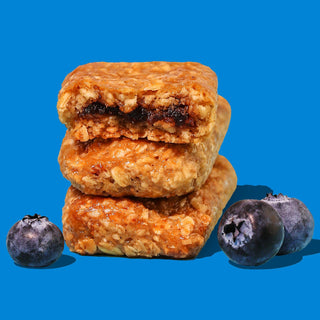Made with:
By Emma Caplan-Fisher
While most people think of figs as a fruit, they're really bulb-shaped, soft flowers with seeds inside. Figs grow in pods and come from hot, dry climates.
The great thing about figs is they're sweet enough to satisfy sugar cravings but in a much healthier way than candy and processed snacks. Here at Bobo's, we've added fig bars to our tasty snack lineup with just that in mind.
Keep reading to learn about the nutrition and health benefits of figs, plus answers to common questions about figs and foods containing them, along with the benefits of both.
Nutritional profile of figs
Vitamins and minerals
Naturally free of fat and cholesterol, figs offer plenty of vitamins and minerals. They're a great source of dietary fiber, vitamins A, B6, C, and K, along with calcium, iron, copper, manganese, potassium, and magnesium.
Natural sugars and carbohydrates
In addition, from figs, you'll get natural sugars and carbohydrates that provide energy. A medium (2.25-inch) fig contains about 8 grams of sugar, 37 calories, and 10 grams of carbohydrates.
Antioxidants
As well, figs are also rich in polyphenols, flavonoids, and other antioxidants and anti-inflammatory chemicals, like carotenoids. These molecules help our bodies fight harmful free radicals that can be linked to health problems, including cancer and diabetes.
Health benefits of figs
Digestive health
Figs contain plenty of fiber and are among the foods that help with digestion, bowel regularity, and gut health. As well, their prebiotic nutrients feed good bacteria in our gut to promote a healthy microbiome, which helps reduce inflammation and improve our immune function.
Heart health
While more research is needed, non-human studies with fig extract show figs can help our heart health by lowering blood pressure or reducing hypertension. This is thanks to the potassium, magnesium, and fiber found in figs, as it helps offset excess sodium. In turn, this can reduce the chance of heart disease and stroke.
Figs can also improve cholesterol levels by raising HDL (good) cholesterol and lowering total cholesterol and triglycerides. As well, antioxidants, like those found in figs, have been found to support cardiovascular health.
Bone health
Figs contain a decent amount of calcium, magnesium, and potassium — minerals that can improve bone density, strength, and health and reduce bone turnover. In the long term, this can help prevent conditions like osteoporosis.
Blood sugar control
Figs can help to steady blood sugar since their high fiber content helps slow sugar absorption, something especially helpful to those with diabetes.A study of type 1 diabetics who drank fig leaf tea daily found their blood sugar levels were reduced and that they needed 12% less insulin. Another study found that drinks with high amounts of fig fruit extract had a lower glycemic index than beverages with no fig fruit extract — meaning blood sugar levels were less impacted.
NOTE: Fig fruit (particularly dried figs) is high in sugar and can therefore increase blood sugar levels in the short term.
Skin health
Figs have been found to support glowing, healthy skin, due to the A and C vitamins and antioxidants they contain.
This has especially shown in those with allergic dermatitis (dry, itchy skin from allergies). A study of 45 children with dermatitis found that a dried fig fruit extract cream applied twice daily for two weeks more effectively treated dermatitis symptoms than a typical hydrocortisone cream treatment. As well, fig extract has been found to show antioxidant effects on skin cells, reduce collagen breakdown, and improve the look of lines and wrinkles.Weight management
Due to the high fiber content in figs, they're satiating and can increase our diet's nutritional density. This leaves us feeling full and eating less, which can help with weight management, making the enjoyment of snacks with figs a healthy way to manage our food cravings and appetite.
Common questions about figs and their health benefits
Are figs good for weight loss?
If you're looking to lose weight, figs can play a role. With plenty of fiber, figs are among the foods that make you feel full for longer. This means you might not experience the food cravings and hunger you otherwise would, which, when acted on, may be counterproductive to losing weight.
Can figs help with digestive issues?
Figs contain plenty of fiber, which aids in digestion, bowel regularity (constipation relief), and gut health. Plus, their prebiotic nutrients send good bacteria to the gut and promote a healthy microbiome, which helps to reduce inflammation and improve our immune function.
Are figs high in sugar?
The simple answer is yes, figs are high in sugar. However, what's more important is understanding that fresh figs contain natural sugar, something much better for us than added or refined sugar.In fact, with about 16.3 grams of sugar per 100-gram portion, figs are in line with or even less than the sugar content of common fruits like apples, bananas, and cherries. These fruits contain anywhere from 15.4 to 25.1 grams of sugar per serving.
The bottom line is that fruit is always a healthier choice than baked treats, candy, or other processed foods, and the USDA recommends about two cups of it daily.
How many figs should I eat in one serving?
Figs can be a great part of a healthy, balanced diet as long as you don't overdo it, as they're high in sugar and can act as a laxative. Up to two or three medium-sized figs daily is a standard portion size for most people.
Foods that contain figs and their benefits
Fresh figs
The easiest, simplest way to enjoy figs? On their own, raw. When consumed this way, you'll get the most nutrients. Plus, they're low in calories and most versatile in different meals, salads, and desserts when prepared fresh and raw.
Dried figs
Dried figs are a concentrated source of nutrients and a great way to enjoy figs in snacks and cooking. Be sure to enjoy these in moderation, as they're higher in calories and sugar than their fresh counterparts.
Fig-based products
There are plenty of fig-based products you can try which offer several nutrients and the ability to promote healthy digestion, manage blood sugar, and decrease the risk of heart disease, among other things. These include fig jams, fig-infused snacks, and fig bars like Bobo's.
Recipes featuring figs
It's easy to incorporate figs into many dishes and snacks you already enjoy. For example:
1. Cut them in half and toss them into your favorite sandwich or salad for some extra flavor and fiber
2. Dice some up and mix them into fresh dough for muffins or other baked goods, in place of raisins or chocolate chips.
3. For a simple snack or dessert, halve some figs lengthwise, season with cinnamon or nutmeg and honey, and roast them for about 40 minutes.
4. Another tasty option: break up a Bobo's fig bar over some creamy frozen yogurt or non-dairy ice cream.












